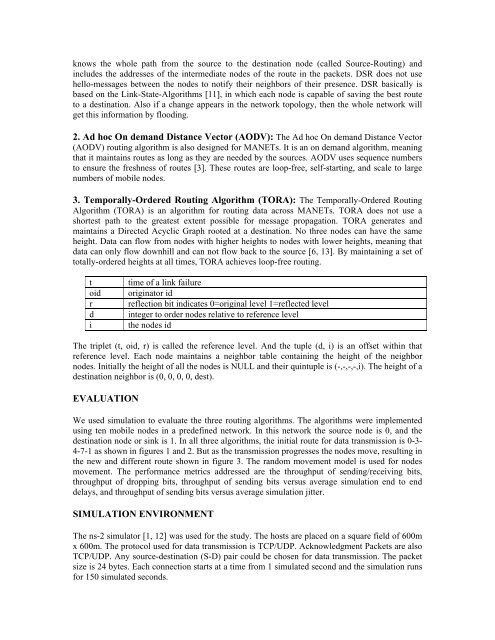Performance Comparison of Ad Hoc Routing Protocols: An ...
Performance Comparison of Ad Hoc Routing Protocols: An ...
Performance Comparison of Ad Hoc Routing Protocols: An ...
Create successful ePaper yourself
Turn your PDF publications into a flip-book with our unique Google optimized e-Paper software.
knows the whole path from the source to the destination node (called Source-<strong>Routing</strong>) and<br />
includes the addresses <strong>of</strong> the intermediate nodes <strong>of</strong> the route in the packets. DSR does not use<br />
hello-messages between the nodes to notify their neighbors <strong>of</strong> their presence. DSR basically is<br />
based on the Link-State-Algorithms [11], in which each node is capable <strong>of</strong> saving the best route<br />
to a destination. Also if a change appears in the network topology, then the whole network will<br />
get this information by flooding.<br />
2. <strong>Ad</strong> hoc On demand Distance Vector (AODV): The <strong>Ad</strong> hoc On demand Distance Vector<br />
(AODV) routing algorithm is also designed for MANETs. It is an on demand algorithm, meaning<br />
that it maintains routes as long as they are needed by the sources. AODV uses sequence numbers<br />
to ensure the freshness <strong>of</strong> routes [3]. These routes are loop-free, self-starting, and scale to large<br />
numbers <strong>of</strong> mobile nodes.<br />
3. Temporally-Ordered <strong>Routing</strong> Algorithm (TORA): The Temporally-Ordered <strong>Routing</strong><br />
Algorithm (TORA) is an algorithm for routing data across MANETs. TORA does not use a<br />
shortest path to the greatest extent possible for message propagation. TORA generates and<br />
maintains a Directed Acyclic Graph rooted at a destination. No three nodes can have the same<br />
height. Data can flow from nodes with higher heights to nodes with lower heights, meaning that<br />
data can only flow downhill and can not flow back to the source [6, 13]. By maintaining a set <strong>of</strong><br />
totally-ordered heights at all times, TORA achieves loop-free routing.<br />
t time <strong>of</strong> a link failure<br />
oid originator id<br />
r reflection bit indicates 0=original level 1=reflected level<br />
d integer to order nodes relative to reference level<br />
i the nodes id<br />
The triplet (t, oid, r) is called the reference level. <strong>An</strong>d the tuple (d, i) is an <strong>of</strong>fset within that<br />
reference level. Each node maintains a neighbor table containing the height <strong>of</strong> the neighbor<br />
nodes. Initially the height <strong>of</strong> all the nodes is NULL and their quintuple is (-,-,-,-,i). The height <strong>of</strong> a<br />
destination neighbor is (0, 0, 0, 0, dest).<br />
EVALUATION<br />
We used simulation to evaluate the three routing algorithms. The algorithms were implemented<br />
using ten mobile nodes in a predefined network. In this network the source node is 0, and the<br />
destination node or sink is 1. In all three algorithms, the initial route for data transmission is 0-3-<br />
4-7-1 as shown in figures 1 and 2. But as the transmission progresses the nodes move, resulting in<br />
the new and different route shown in figure 3. The random movement model is used for nodes<br />
movement. The performance metrics addressed are the throughput <strong>of</strong> sending/receiving bits,<br />
throughput <strong>of</strong> dropping bits, throughput <strong>of</strong> sending bits versus average simulation end to end<br />
delays, and throughput <strong>of</strong> sending bits versus average simulation jitter.<br />
SIMULATION ENVIRONMENT<br />
The ns-2 simulator [1, 12] was used for the study. The hosts are placed on a square field <strong>of</strong> 600m<br />
x 600m. The protocol used for data transmission is TCP/UDP. Acknowledgment Packets are also<br />
TCP/UDP. <strong>An</strong>y source-destination (S-D) pair could be chosen for data transmission. The packet<br />
size is 24 bytes. Each connection starts at a time from 1 simulated second and the simulation runs<br />
for 150 simulated seconds.
















